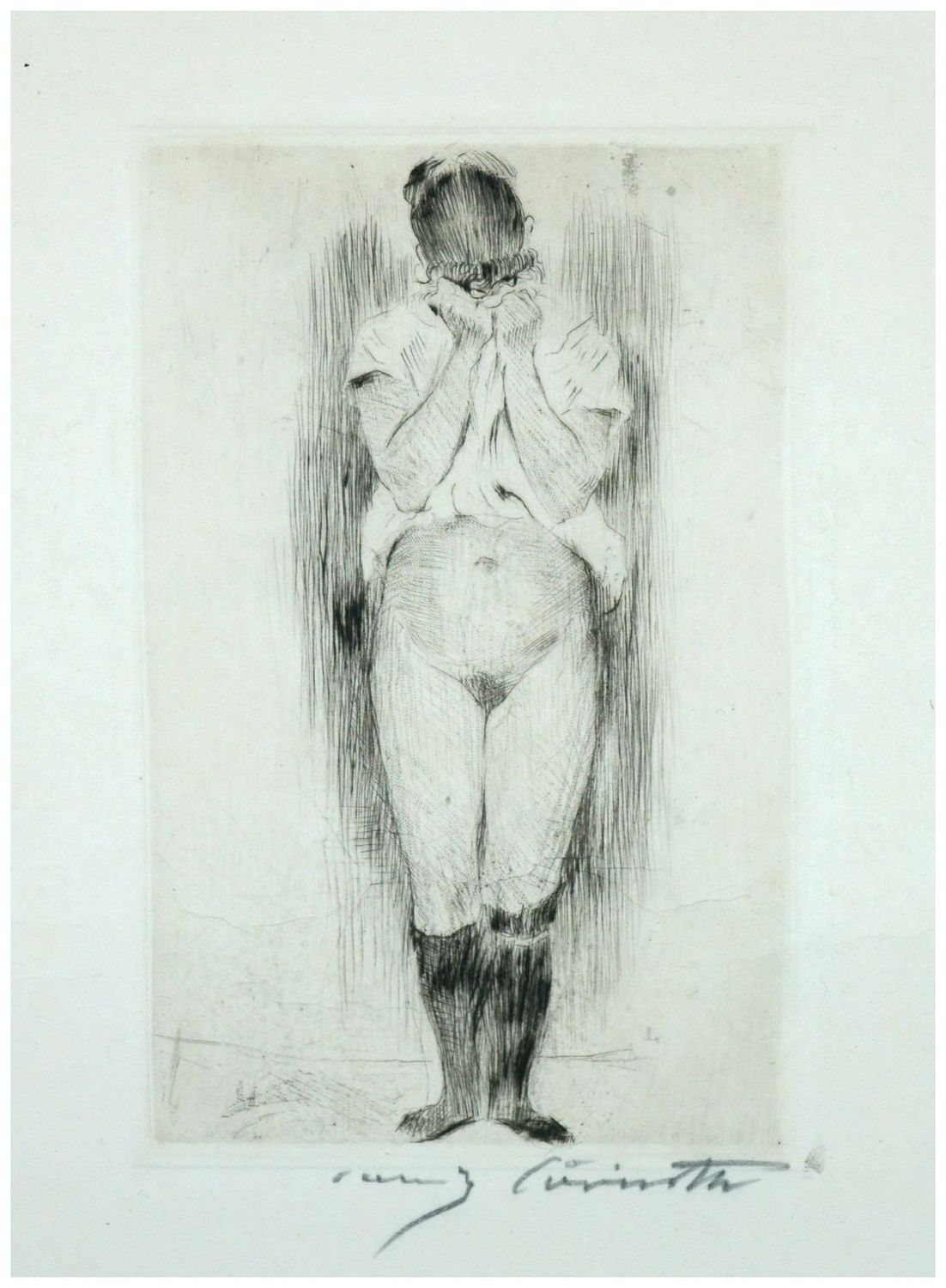Corinth, Lovis (1858-1925), Weinendes Mädchen, 1899
Lovis Corinth(1858 Tapiau - 1925 Zandvoort), Weinendes Mädchen , 1899 (Schwarz 20). Mit Bleistift handsignierte Kaltnadelradierung auf festem Japan. 15 x 10 cm (Platte), 35 x 27 cm (Blatt), links unten Trockenstempel des Bruno Cassirer Verlags (L. 3638).
- Kräftiger präziser Abdruck. Papierbedingte minimale Quetschspuren im unteren Drittel der Darstellung. Der breite Rand außerhalb der Darstellung nachgedunkelt, verso Schatten einer alten Montage.
Exposé als
PDF
- Versteckt und entblößt zugleich -
Das vergleichsweise kleine Format und der einzig angedeutete, von der Figur ganz durchmessene Raum schafft einen intimen Rahmen, in welchem ein weinendes Mädchen zur Darstellung kommt. Um in ihrer Trauer ganz für sich zu sein, verbirgt sie mit dem Kleid das Gesicht. Dieses Verstrecken ist aber zugleich ein Entblößen, da sie, ohne es selbst zu bemerken, durch das Anheben des Kleides nackt dasteht. Es handelt sich also um eine doppelte Intimität, die sich ambivalent zueinander verhält: Wir wohnen der Trauer bei, die alleine für sich bleiben möchte und werden dabei zugleich dem unwissentlich entblößten Körper ansichtig, der das Einfühlen in die Trauer konterkariert.
Aus dieser Ambivalenz von Trauer und Eros resultiert die Spannung des Bildes, die umso wirkmächtiger ist, da sie nicht artifiziell hervorgerufen wurde, wie dies der Fall wäre, wenn Corinth der Tradition der akademischen Aktmalerei gefolgt wäre. In Paris hatte er sich in der privaten Académie Julian intensiv mit der Aktmalerei beschäftigt. Mit der Radierung „Weinendes Mädchen“ steht das Resultat vor Augen, einen neuen Akt zu schaffen, der nicht artifiziell, sondern authentisch wirkt oder – in anderen Termini formuliert – nicht traditionell akademisch, sondern naturalistisch ist. Dazu gehört, dass der Körper nicht auf Hochglanz poliert wurde und auch keinem lehrbuchmäßigen Schönheitsideal entspricht, sondern aus dem alltäglichen Leben gegriffen zu sein scheint.
Gerade in der Darstellung der Authentizität des Körpers zeigt sich Corinths Meisterschaft mit der Radiernadel: Vor einem senkrecht schraffierten dunklen Fond hebt sich der Körper des Mädchens ab, dessen haptisch wirkende Fleischlichkeit aus zarten, virtuos gesetzten Strichlagen hervorgeht. Dabei sind die Strichlagen zugleich Darstellungsmittel und – wie bei den spannungsvollen Haarsträhnen – Bildgegenstand.
zum Künstler

Entschlossen Künstler zu werden, trat Corinth 1876 in die Kunstakademie Königsberg ein, wo er bei Otto Günther studierte, der ihm die Weimarer Freilichtmalerei nahebrachte. Auf Günthers Empfehlung wechselte Corinth 1880 an die Münchner Kunstakademie. Unter dem Einfluss des Leibls-Kreises und Wilhelm Trübners folgte er dort einem naturalistischen Kunstverständnis, das gegen die akademische Historienmalerei gerichtet war.
Nach einer einjährigen Studienunterbrechung zur Ableistung eines freiwilligen Militärdienstes begab sich Corinth 1883 auf eine Studienreise nach Italien und im Folgejahr nach Antwerpen, wo er bei Paul Eugène Gorge Kunstunterricht nahm. 1884-1887 weilte Corinth in Paris und widmete sich an der privaten Académie Julian vor allem der Aktmalerei.
Nach einer Zwischenstation in Berlin, wo er Max Klinger, Walter Leistikow und Karl Stauffer-Bern kennenlernte, lebte Corinth von 1891-1901 in München und wurde Gründungsmitglied der 1892 ins Leben gerufenen Münchener Secession, der sich Max Liebermann, Otto Eckmann, Thomas Theodor Heine, Hans Olde, Hans Thoma, Wilhelm Trübner, Franz von Stuck und Fritz von Uhde anschlossen. Aus der Sezession ging die Abspaltung Freie Vereinigung der XXIV oder Münchner 24 hervor, zu der auch Corinth gehörte.
Von Otto Eckmann angeleitet erlernte Corinth 1894 die Kunst des Radierens und entwickelte auf dem Feld der Malerei die für sein Werk prägende Nass-in-Nass-Malerei, die zum reliefartigen Duktus seiner Gemälde führte.
Die Beziehungen nach Berlin wurden immer intensiver. Als er 1899 zur ersten Ausstellung der Berliner Secession fuhr porträtierte er Liebemann, der seinerseits ein Porträt von Corinth anfertigte. Nachdem die Münchner Sezession sein Bild Salome abgelehnt hatte, zog er endgültig nach Berlin, wo das Gemälde auf der dortigen Sezessionsausstellung Bewunderung fand und Corinth – von Leistikow vermittelt – zum gefragten Porträtmaler wurde.
1903 eröffnete Corinth eine Malerschule und heiratete 1904 seine erste Schülerin Charlotte Berend. Von Paul Cassirer veranstaltet erfolgte die erste Einzelausstellung. In Berlin begann sich Corinth auch dem Theater zu widmen. Er arbeitete mit Max Reinhardt zusammen, entwarf Bühnenbilder und Kostüme.
Nach dem Rücktritt Max Liebermanns wurde Corinth 1911 zum Vorsitzenden der Secession gewählt. Im selben Jahr erlitt er einen Schlaganfall, der ihn halbseitige lähmte. In der Folge wandte er sich intensiv der Grafik zu und erschloss sich das Feld der Buchillustration.
1913 veranstaltetet Paul Cassirer die erste große Retrospektive und zum 60. Geburtstag Corinths widmete ihm die Berliner Secession 1918 eine großangelegte Werkschau. 1923, zu seinem 65. Geburtstag, wurde seine künstlerische Karriere mit einer umfassenden Einzelausstellung in der Nationalgalerie gekrönt.
Auch nach der Abspaltung der "Freien Secession" von der "Berliner Secession" verblieb Corinth in der ursprünglichen Vereinigung und wurde 1915 erneut Vorsitzender und im Folgejahr zum Professor an der Berliner Akademie der Künste ernannt.
1919 erwarben die Corinths den Rückzugsort am bayerischen Walchensee, den zu Corinths in über 60 Bildern festhielt. Auf einer Reise nach Amsterdam zu seinen großen Vorbildern Frans Hals und Rembrandt verstarb Corinth im Jahre 1925.
Auswahlbibliographie
Heinrich Müller: Die späte Graphik von Lovis Corinth, Hamburg 1960.
Thomas Deecke: Die Zeichnungen von Lovis Corinth. Studien zur Stilentwicklung, Berlin 1973.
Zdenek Felix (Hrsg.): Lovis Corinth. 1858–1925, Köln 1985.
Karl Schwarz: Das Graphische Werk von / The Graphic Work of Lovis Corinth, San Francisco 1985.
Horst Uhr: Lovis Corinth, Berkeley 1990.
Charlotte Berend-Corinth: Lovis Corinth: Die Gemälde. Neu bearbeitet von Béatrice Hernad, München 1992.
Peter-Klaus Schuster / Christoph Vitali / Barbara Butts (Hrsg.): Lovis Corinth, München 1996.
Michael F. Zimmermann: Lovis Corinth, München 2008.

